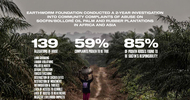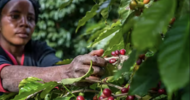
A section of the Lao-China high-speed railway crosses rice fields in a suburb of the Lao capital Vientiane in a photo taken in 2021
Lao farmers driven from their land by foreign concessions, rising costs
Hardest hit has been the cultivation of rice, an important staple food in the landlocked Southeast Asian country, the sources said.
“Many farmers in our province don’t want to do farm work anymore,” a farmer in Vientiane province told RFA in a recent interview. “And more specifically, they don’t want to grow rice. Most of our young people are now going to the capital Vientiane to work as laborers,” he said.
“The residents of my village have all scattered during the last ten years,” said one former rice farmer in southern Laos’ Savannakhet province, now working in Thailand. “Most of the young men have gone to work in Thailand, with some also going to cities like Vientiane.”
“Only a small number of the older folks have stayed in the village to grow rice,” he added.
The number of Lao villagers currently working farms in the country has sharply declined in the last ten years, according to a survey released on June 30, 2021 by the Lao National Statistics Bureau of the Ministry of Planning and Investment.
“The percentage dropped from 77 percent of the total population [of 7 million] in 2010 down to 69 percent in 2020 because many Laotians gave up farming and then left their farms to be laborers in the cities,” according to the bureau’s report.
Much of the land no longer farmed was lost to China-backed railway, dam, and other infrastructure projects, sources in the country said.
“Before, I grew rice for a living,” a villager in the town of Xay, capital of Oudomxay province in northern Laos, told RFA. “But I lost 1.5 hectares of rice field to the Laos-China high-speed railway project.”
“I received $96,000 compensation for my land, but with that money I couldn’t buy another lot of land of the same size to farm. So I set up a small shop in the village,” he said.
Another farmer said he had lost a large rice field in a suburb of the capital Vientiane to a large Chinese-invested development project called the That Luang Marsh Special Economic Zone project. “So now I don’t farm at all. I became a day laborer, and my wife runs a small shop,” he said.
Flooded farmland
China-backed dam projects have also impacted Lao farming, leaving large areas of farmland flooded and displacing thousands of Lao villagers who have been moved to resettlement towns where they find it hard to make a living.
“We lost all our farmland to the Nam Theun 1 Dam project and moved to a resettlement village,” a resident of Houay Hoi Village in Borikhamxay province’s Viengthong district told RFA. “Now we have no land left to farm,” he said.
“The agriculture ministry told us that the new land that will be allocated later is good only for raising poultry and livestock, and not for growing rice and other crops,” he said.
“Before, we were all farmers, but now many of us have left to go to the cities to work. Some have become the owners of small shops, but many do nothing now but live on the allowance provided to us by the dam project.”
“My rice field is permanently flooded by a hydropower project,” said a farmer in Xieng Khouang province, “and I can’t grow rice now either in the rainy season or the dry season, because my field is located upstream from the dam.”
Up to 10,000 villagers were displaced by the Nam Tha 1 Dam in Luang Namtha province’s Na Lae district, a district villager said, adding, “So far around 400 of them have left the resettlement village and now work for Chinese tea and watermelon plantations near [the province’s capital].”
“The rest are waiting for the government to clear and allocate some land for them," he said.
Rising costs, climate change
Rising costs have also driven Lao farmers from their land to look for other kinds of work, sources said.
“Before, I grew two crops of rice each year for many years, but now it’s not worth growing rice anymore,” a farmer in Attapeu province in southern Laos said. “I’m thinking about quitting farming because the costs are getting higher and I’m producing less.”
“Labor and fertilizers are both getting more expensive. I wish that I could do something else,” he said.
“It’s too expensive to grow rice nowadays. It’s just not worth it,” agreed a rice farmer in the Songkhone district of Savannaket province in southern Laos, citing both rising costs and the damages caused by climate change.
“During the last two years, floods destroyed our rice production to around half of what we produced five years ago. And two years before that, the same thing happened due to drought,” he said. “That’s why so many people have stopped farming, and more specifically why they’ve stopped farming rice.”
Also speaking to RFA, Pornpana Koaycharoen from the NGO Land Watch Thailand said that Laos, like other Southeast Asian countries, is steadily losing its agricultural workforce. “But Lao farmers in the countryside are very poor, vulnerable, and unable to adjust to the situation,” she said.
“They have lost a lot of land to large investment projects and land concessions. They’ve relied on farming and on their natural environment, and now they’ve been seriously affected.”
“Land concessions and investment projects have undermined the livelihoods, food sources, and income of local people,” agreed a member of the Bangkok-based NGO Global South. “In Laos over the last ten years, farmers have lost thousands of hectares of their farmland to these concessions and development projects.”
Other workers needed
Speaking to RFA, an official of the Lao Planning and Investment Ministry agreed that Laos now has fewer farmers.
“But Laos still has almost one million hectares of rice field under cultivation, and can not only produce enough rice for its own population but also sell a part of it to its neighboring countries,” the ministry official said, speaking on condition of anonymity.
“Not everyone has to be a farmer,” he said. “Other sectors also need labor. Our service sector is expanding and our manufacturing industry is also growing. The more our economy grows, the fewer farmers we’ll have.”
Much of Laos’s recent economic growth has been generated through land concessions to China, Thailand, and Vietnam to exploit natural resources including timber, agricultural products, minerals, and energy.
But the projects have sparked friction over cases of environmental pollution and land taken without proper compensation, and Lao villagers affected by land grabs often fear to speak out publicly over their concerns because they fear official retaliation.












